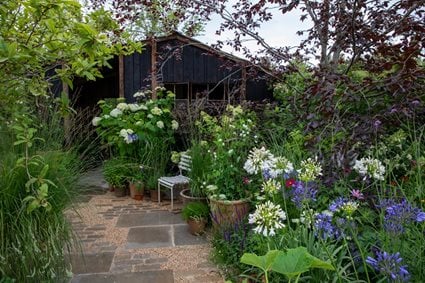This pollinator paradise promotes ‘B-Lines’, a network of ‘insect pathways’ stretching across the UK that will in time provide corridors of nectar-rich habitat for bees and other pollinators. Bursting with wildflowers and ornamentals, the garden reveals how any space can contribute to the network increasing flower abundance and habitat for bee resilience.
Ribbons of Linaria purpurea (purple toadflax) and Salvia ‘Carradonna’ weave across the garden, while a bee friendly mosaic structure incorporates drought tolerant plants such as Verbascum thapas (great mullein), Daucus carota (wild carrot) and Eryngium planum ‘Blue hobbit’ (blue eryngo) to more typical herbaceous mixed-border style planting with plants such as Digitalis ferruginea ‘Gelber Herold’ (rusty foxglove), oregano and yarrow. Sculptural bee towers, cob nesting material and bare ground add essential nesting habitat for an array of bee species.
At a glance:
Who is this garden for?
Urban communities
Where is the garden set?
South London.
Who or what is the design inspiration?The B-Lines vision of a future with nectar rich ‘insect pathways’ across the UK
Key sustainability points
- Sustainably sourced mulch materials include recycled UK construction waste, composted bark and recycled sand.
- Natural cob bricks made of earth, straw or hay, sand and water forms bee nesting material.
- Repurposed Devon wood has been used to make bee habitat, including the bee towers
Relocation and repurpose
The garden has been sponsored by Buglife and the London Buzzing project and will be relocated to communities in London including The Tabard Garden Allotments and the Devonshire Road Nature Reserve after the show.All Show Gardens


Show Features
Furzey Gardens – Reflective Waters of Inclusivity
Furzey Gardens – Reflective Waters of Inclusivity





Show Features
Furzey Gardens – Reflective Waters of Inclusivity
Furzey Gardens – Reflective Waters of Inclusivity



Get involved
The Royal Horticultural Society is the UK’s leading gardening charity. We aim to enrich everyone’s life through plants, and make the UK a greener and more beautiful place.




